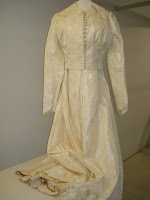The keys to success in textile restoration lie in the Company you choose. Speed is critical. The faster the response, the sooner the restoration process can begin, the higher the success rate will be in more garments.
Knowledge is also critical. Knowledgeable textile restorers will always ask “what type of fire occurred?” Soot and smoke will vary dependant upon the different types of fires (i.e. electrical, wood, plastic, protein-cooking oils, etc). Each type is treated differently based upon the differing chemical make-up of the smoke or soot. The successful removal of these and other contaminants requires both a scientific and customized approach that is only achievable by professionals.
Homeowners should be warned against cleaning their own garments using their own residential laundry equipment. First of all, until the dryer duct work is cleaned, the soot and smoke odor can redeposit into the clothes during the drying process which further inhibits the success rate of restoring the clothes. Secondly, homeowners generally do not have access to the appropriate cleaning agents, water temperatures and agitation needed for safely cleaning and restoring garments. Additionally, knowledgeable textile restorers can identify which fabrics will respond best to either dry or wet cleaning methods—neither of which are available in residential or even laundromat settings.
A Comprehensive Approach saves time, money, and garments! Good textile restorers will have a manager on site to work with the insured, the adjuster, & the contractor to identify the scope of the project and to manage expectations of results and timeline. They will remove textiles from the loss site by room, inventory all items, and return all items to back to the same rooms. Rush turnarounds of identified garments are imperative. Inventory lists and cost estimates should be supplied within 72 hours of the loss. Non-salvageable or non-restorable items should be included on the list—at no charge.
An excellent garment restoration company stands behind their work with confidence and integrity and will work with the insureds to insure their satisfaction so the adjuster and the mitigation contractor don’t have to waste their time on this aspect of the loss.
Trained and skilled garment care professionals can help to mitigate losses and minimize claims, thereby benefitting the insureds, the insurance companies, adjusters and other mitigation contractors.
___________________________________
If you have additional questions, professionals at Treasured Garment Restoration are available to answer! You can visit us on the web: http://www.treasuredgarmentrestoration.com/
or call us at (651) 351-3951.
Tuesday, March 23, 2010
Wednesday, March 17, 2010
Something Old...
Something old, something new, something borrowed, something blue...as the old saying goes! Some brides are making the "something old" the cornerstone of the wedding--her dress! More and more I see brides pulling out Mom's or Grandma's gown from the attic and discovering that it's in pretty good shape, but maybe yellowed, a few dark brown spots, and a few little tears. They come in wondering if, somehow, it may be salvageable?
My answer--most likely! Since each gown is different, has been cleaned (or not cleaned) differently, and has been stored differently--some in boxes with tissue, some in cedar chests, some hanging in the back of Grandma's closet--they all come with a variety of challenges. But, unless the integrity of the fabric has been seriously compromised (i.e. brittle and crumbly or tearing with little tension), it's probably a great candidate for restoration and re-wearing.
Check out a couple more examples:
My answer--most likely! Since each gown is different, has been cleaned (or not cleaned) differently, and has been stored differently--some in boxes with tissue, some in cedar chests, some hanging in the back of Grandma's closet--they all come with a variety of challenges. But, unless the integrity of the fabric has been seriously compromised (i.e. brittle and crumbly or tearing with little tension), it's probably a great candidate for restoration and re-wearing.
1951 Silk Gown Before (the bride was going to cut off the bottom to make it a T-length dress)
1951 Gown After (the bride decided to leave it long since most of the latent stains were removed).
The restoration process involves removing the oxidation (yellowing) and returning the fabric to its original color and luster. Yes, this is possible and done quite frequently by professionals who know how to handle vintage and age-damaged fabrics. It may also be the most economical choice for the bride, as well. Since each wedding dress differs dramatically, prices may also vary, but usually can start around $399 and up!Check out a couple more examples:
1946 Wedding Gown Before. Note the discoloration of beads and sequins.
1946 Wedding Gown After! Color is restored and so are beads and sequins!
Friday, March 12, 2010
If it's historic clothing, he can clean it
Check out the Sunday Pioneer Press article written about our own Duane Schumann, Restoration Production Manager:
Stillwater restoration specialist Duane Schumann has cleaned, cared for and revived some precious garments in his day. The work is a little bit surgery, a little bit chemistry and a whole lot of confidence in his unique ability to accomplish the task at hand.
If it's historic clothing, he can clean it - TwinCities.com
Stillwater restoration specialist Duane Schumann has cleaned, cared for and revived some precious garments in his day. The work is a little bit surgery, a little bit chemistry and a whole lot of confidence in his unique ability to accomplish the task at hand.
If it's historic clothing, he can clean it - TwinCities.com
Subscribe to:
Comments (Atom)






